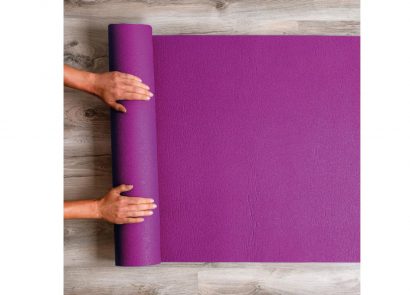Can you remember the last time you took an hour out of your day, one that was completely and utterly devoted to you? No distractions, no stress, no worries, absolutely nothing. You’re sadly not in the minority if you said no.
Research conducted on behalf of Interflora (interflora.co.uk) and mental health charity SANE (sane.org.uk) found that, while 70 per cent of Brits think that mindfulness and taking time for themselves is important, only 15 per cent manage to do so daily. Busy schedules and difficulty finding time alone were cited as reasons for this, showing the need for some much deserved R&R!
“We spend much of our time in ‘doing’ mode, whether that’s physical doing, such as running errands, or mental doing, such as thinking, remembering, judging, analysing and problem solving,” says psychologist Dr Victoria Galbraith (drvictoriagalbraith.co.uk).
“While it’s amazing that we have brains with the capacity to do all of the above if we are constantly engaged in ‘doing’ mode, we are likely to become more stressed and have the potential to burn out. Science tells us that, if we can pause and take time out once in a while (ideally on a daily basis), we stand a better chance of both physical and emotional health. After all, we’re human beings, not human doings! When you’re feeling stressed, the sympathetic nervous system is activated, with adrenaline running through your body, but taking time out engages the parasympathetic system (also known as the calming system), which is good for both physical and psychological health.” Dr Victoria likens this to being on a plane and putting on your own oxygen mask before helping others – you must take care of yourself first.
“There are obviously physical reasons for this – how can you possibly help others if you run out of oxygen?” she says. “The same goes for emotional health – we all know that if we become stressed and fatigued, we’re likely to become more irritable, possibly with accompanying negative and critical thinking towards ourselves and others, so rid yourself of these bad feelings and put your own ‘oxygen mask’ on first.”
But how can you stop feeling guilty about it?
This all comes down to making yourself a priority and learning to say no. “Go through your diary and work out what isn’t essential, whether it’s something at home, work, or something others have asked you to do, and weed out tasks that don’t require your time,” life coach Chloe Leibowitz (chloeleibowitz.com) advises.
“Get tough and remember that putting yourself first is the least selfish thing you can do. Giving yourself the gift of me-time means you are a stronger, calmer, more organised, focused and happier version of yourself – that is definitely a win for you and everyone else in your life! You do not need to change everything at once in an attempt to incorporate some relaxation time – one step at a time is just fine! Allowing five or 10 minutes for some quiet reflection, or a mindful activity is enough to calm down the tumbling thoughts and feelings that overwhelm you. Brainstorm activities you would love to do for yourself, and how much time they require. You could try writing in a journal, going for a walk, reading, or even baking.” No matter how much time you have, here are some other ways to enjoy doing nothing!
If you have 45 minutes: Try Sophrology
You may have heard of this mindful mindset –here’s how to practise it. “Sophrology combines meditation techniques with gentle movement and visualisation to help relax the body while keeping the mind alert,” explains David Brudö, CEO and co-founder of the mental wellbeing platform, Remente (remente.com).
“If you are feeling anxious and stressed, or have difficulty sleeping, sophrology is one technique that can help you to feel more relaxed and focused. This type of moving meditation, or dynamic relaxation, was founded in Spain in 1960 by a neuropsychiatrist called Prof Alfonso Caycedo. He spent decades exploring ancient meditation and mindfulness techniques, such as yoga and hypnosis, to create a method of training for the mind and body that allows people to reach a new level of consciousness. A session per day is said to help promote concentration, relaxation and mental wellbeing. As with any meditation, it’s good to begin by taking guided classes, either in a group or one-to-one, and after a while, you could start to explore this technique on your own.”
If you have 2o minutes: Do meditate
“Meditation is your reset button. It’s not just about feeling good or stopping your thoughts – that’s impossible,” explains life coach and meditation guide Lynette Gray. “It’s about becoming aware of your thoughts. Accepting all parts of yourself. Silencing your inner critic and turning the volume up on your inner ‘best friend’. When you meditate you rewire your brain and strengthen your emotional intelligence, which is key to both personal and professional success. By doing nothing, you do so much more. Meditation looks different for everyone, and it’s about finding your own flow with it. My meditation journey started with YouTube guided meditations, but there are apps and amazing courses out there, explore what works for you.”
If you have 5 minutes: Put the kettle on
Neil Seligman, author of 100 Mindfulness Meditations (neilseligman.com) recommends this routine for a mindful tea-break, without any technology or distraction.
1. Before you start, remember to do whatever is needed in order to feel comfortable. Disconnect from technology for the length of your break. Set a timer if it will allow you to be more relaxed.
2. Prepare your favourite drink and take it to a restful spot. It could be the sofa, a park bench or the old chair in the garden. Get really comfortable. It’s not a meditation posture, so curl up, pull a blanket over if you like, and relax. Hold the mug close and breathe. Deeply inhale.
3. Let go completely and exhale. Sink into the seat, sink into the peacefulness of this moment, sink into the now. Allow yourself to land fully in the freedom of these moments, dedicated to noticing what is arising within.
4. Take a sip. How do you feel? Take another sip. What do you notice in your body? Another sip. What thoughts are bubbling up in your mind? Let all of it be just as it is, and breathe – deep, open, calming breaths. Drink. Contemplate. Be.
If you have 1 minute: Breathe deeply
“You breathe, on average, 20,000 times a day, and yet most of us are unaware of its incredible ability to transform the way we feel,” says Stuart Sandeman, transformational breath coach at Breathpod (breathepod.me). “Conscious breathing is a powerful tool to give yourself an instant break in any place, time or situation.”
1. Sit up straight with your feet on the floor and close down your eyes. Slowly exhale to expel all the oxygen out of your lungs.
2. Then, inhale slowly and deeply, through your nose to a slow count of four. Feel the air fill your lungs until they are completely full.
3. Hold your breath for another slow count of four. Exhale through your mouth for the same slow count of four. Be conscious of the feeling of the air leaving your lungs.
4. Hold your breath for the same slow count of four as before. Repeat for four rounds.





















